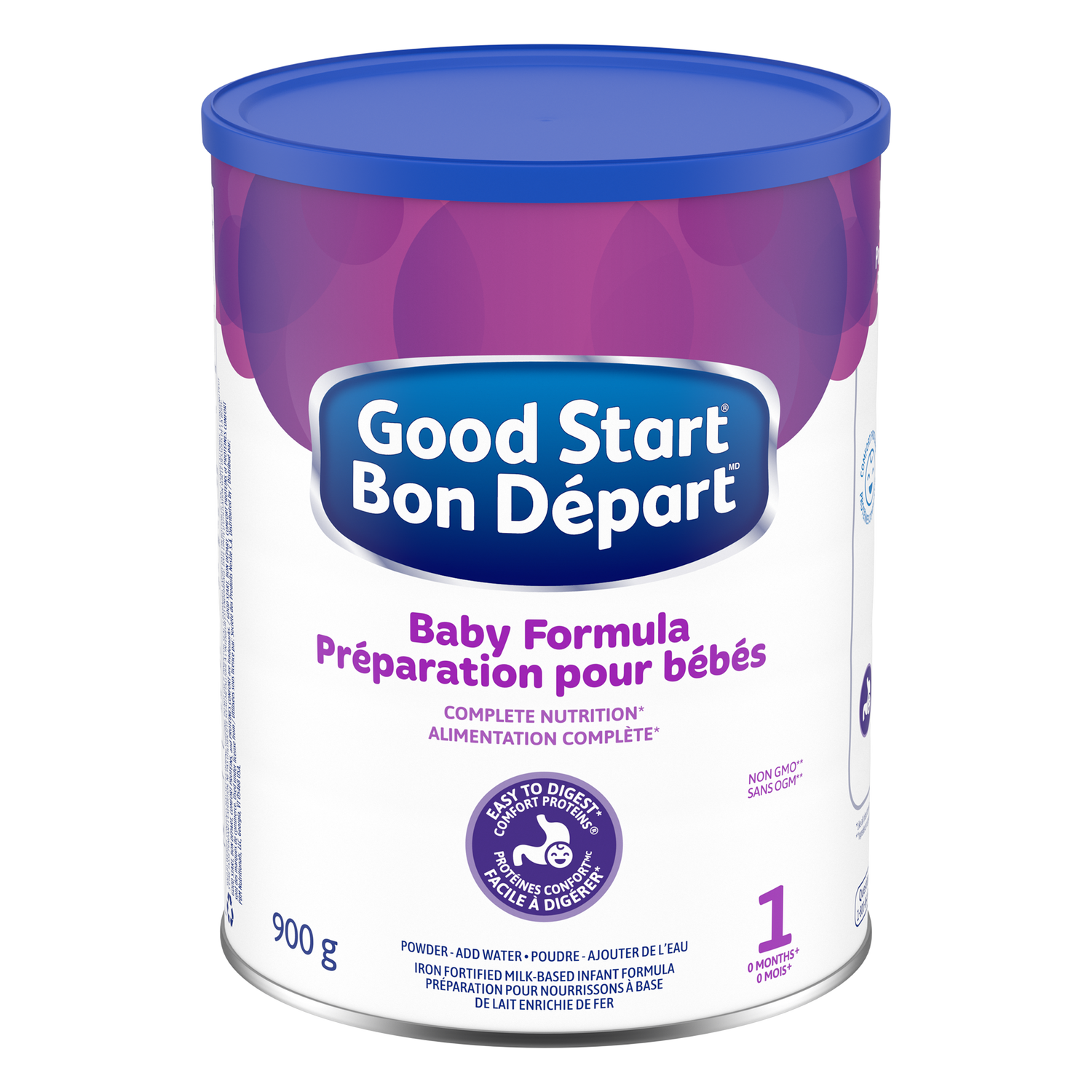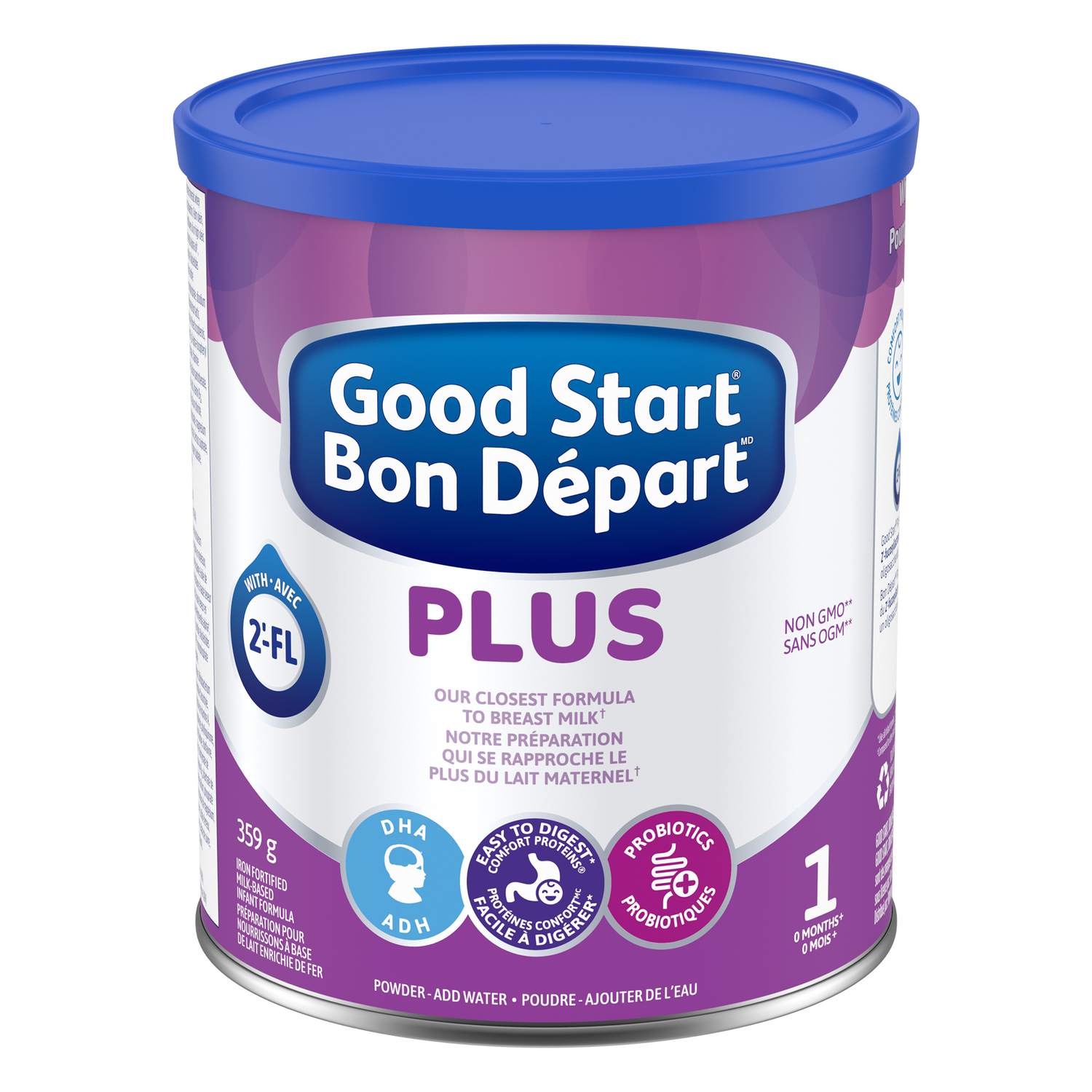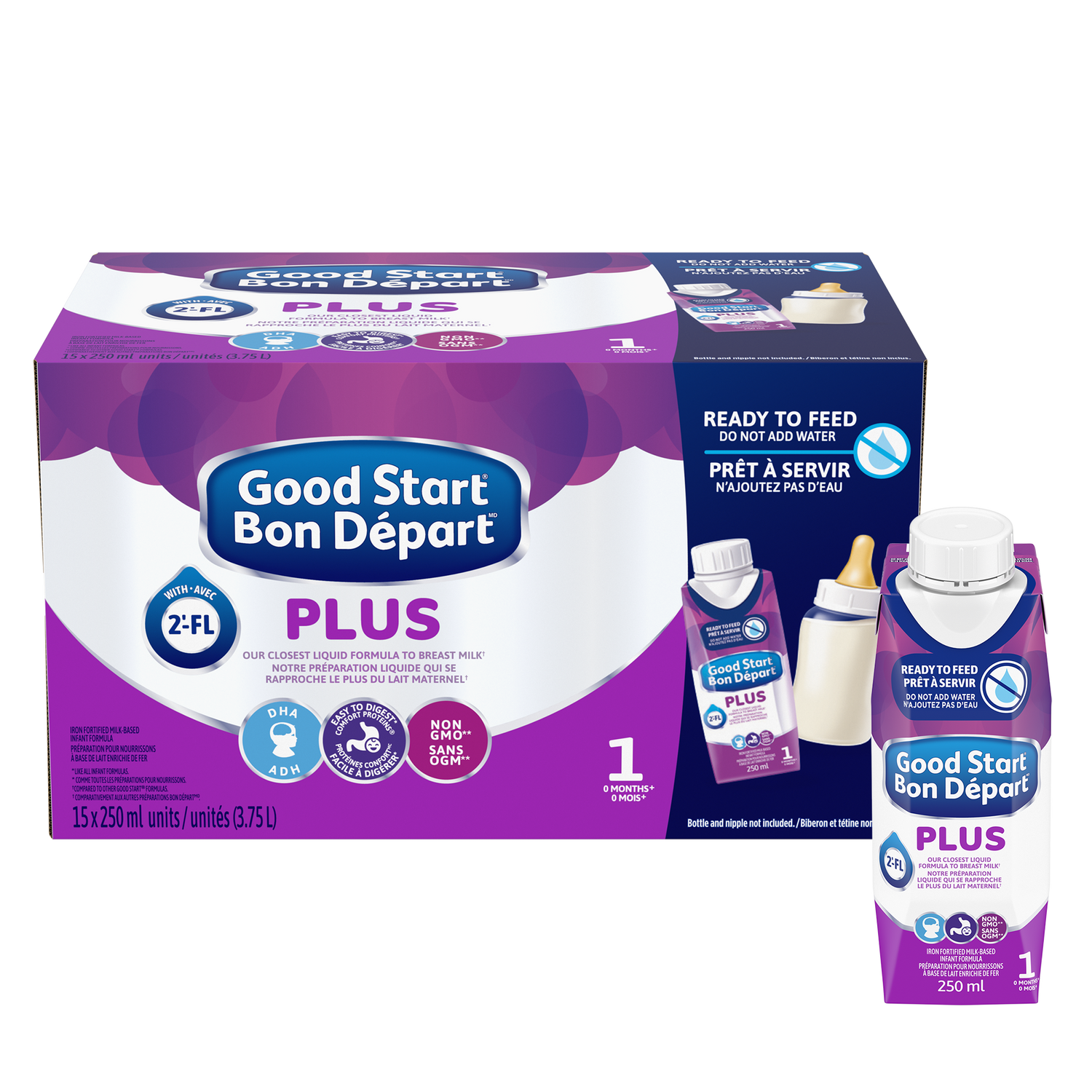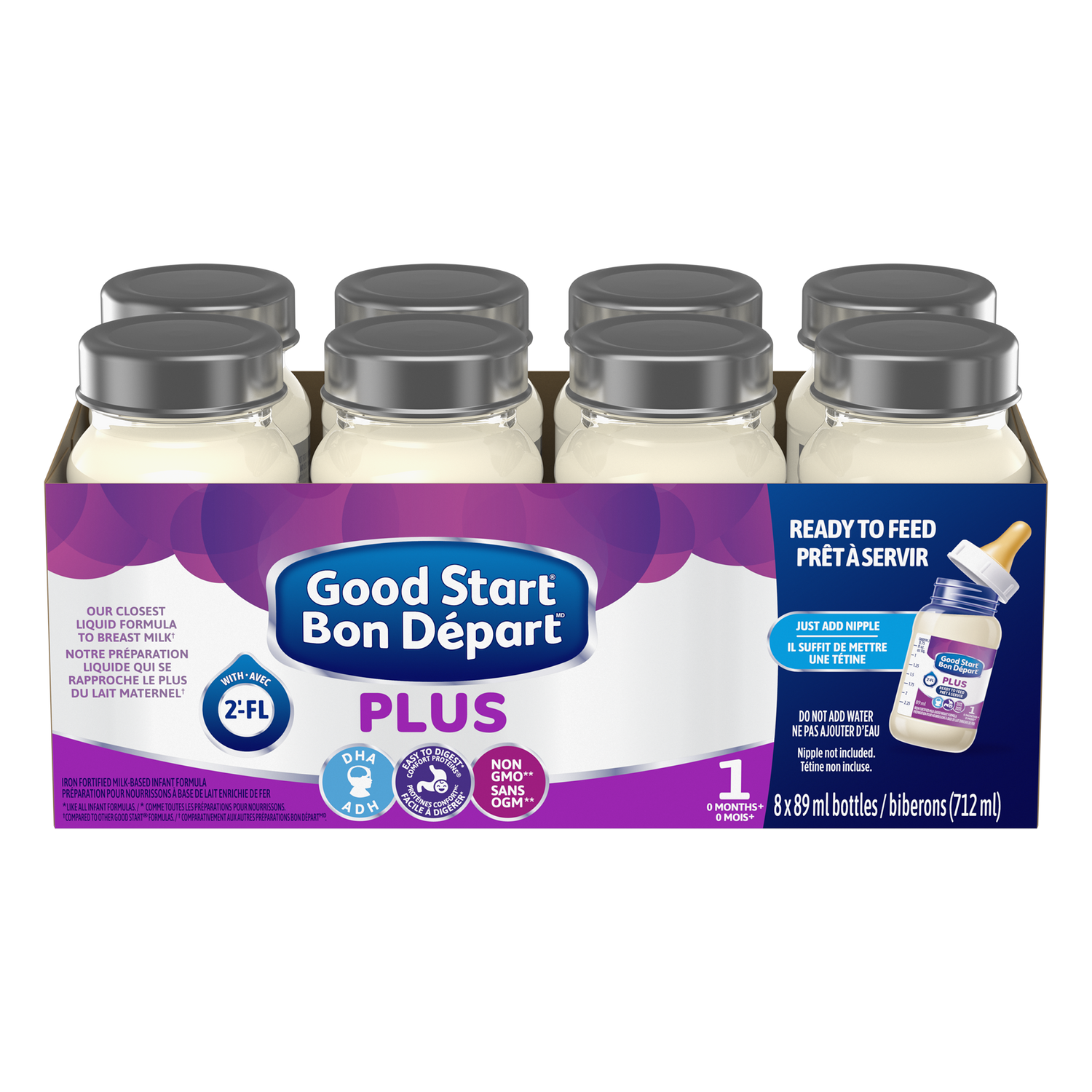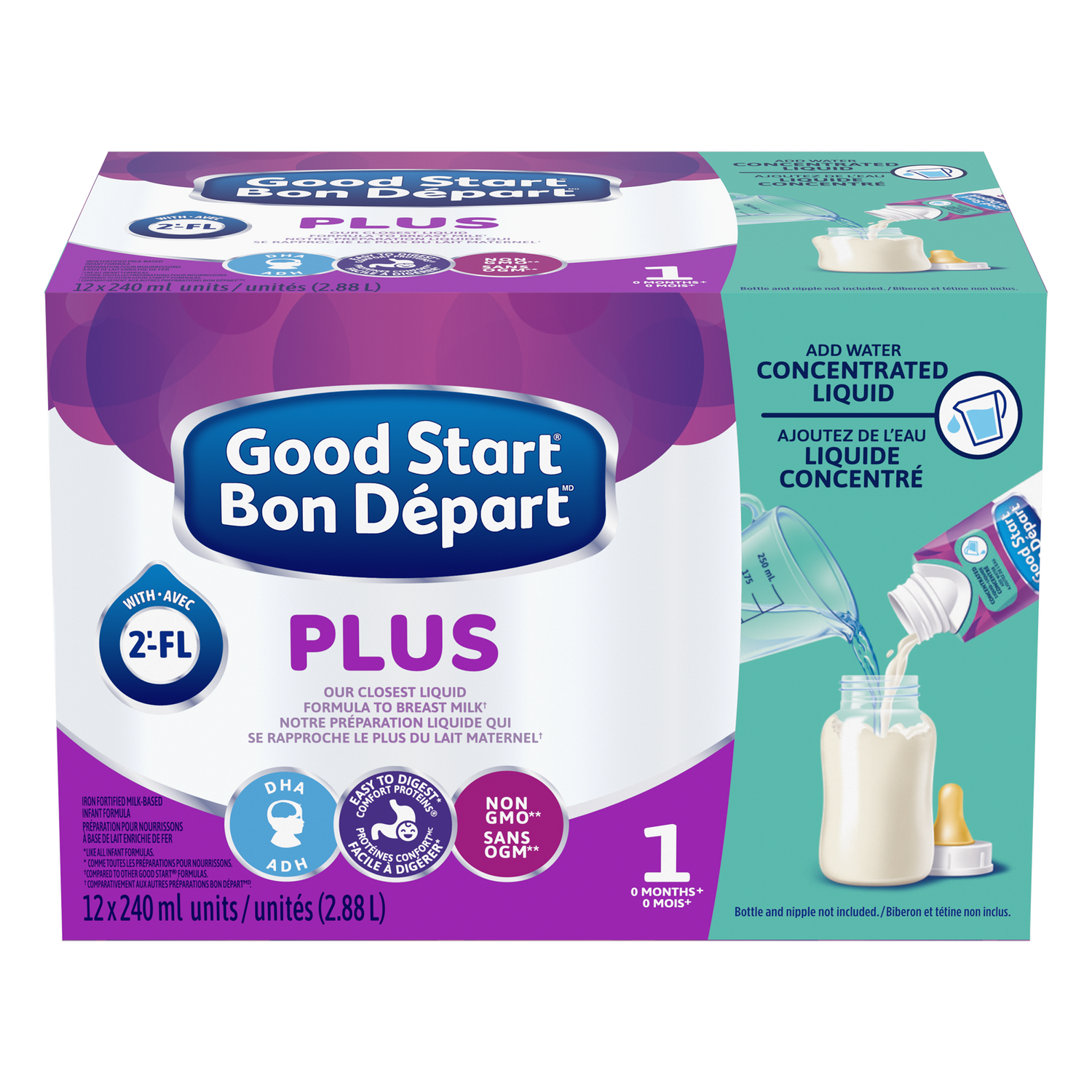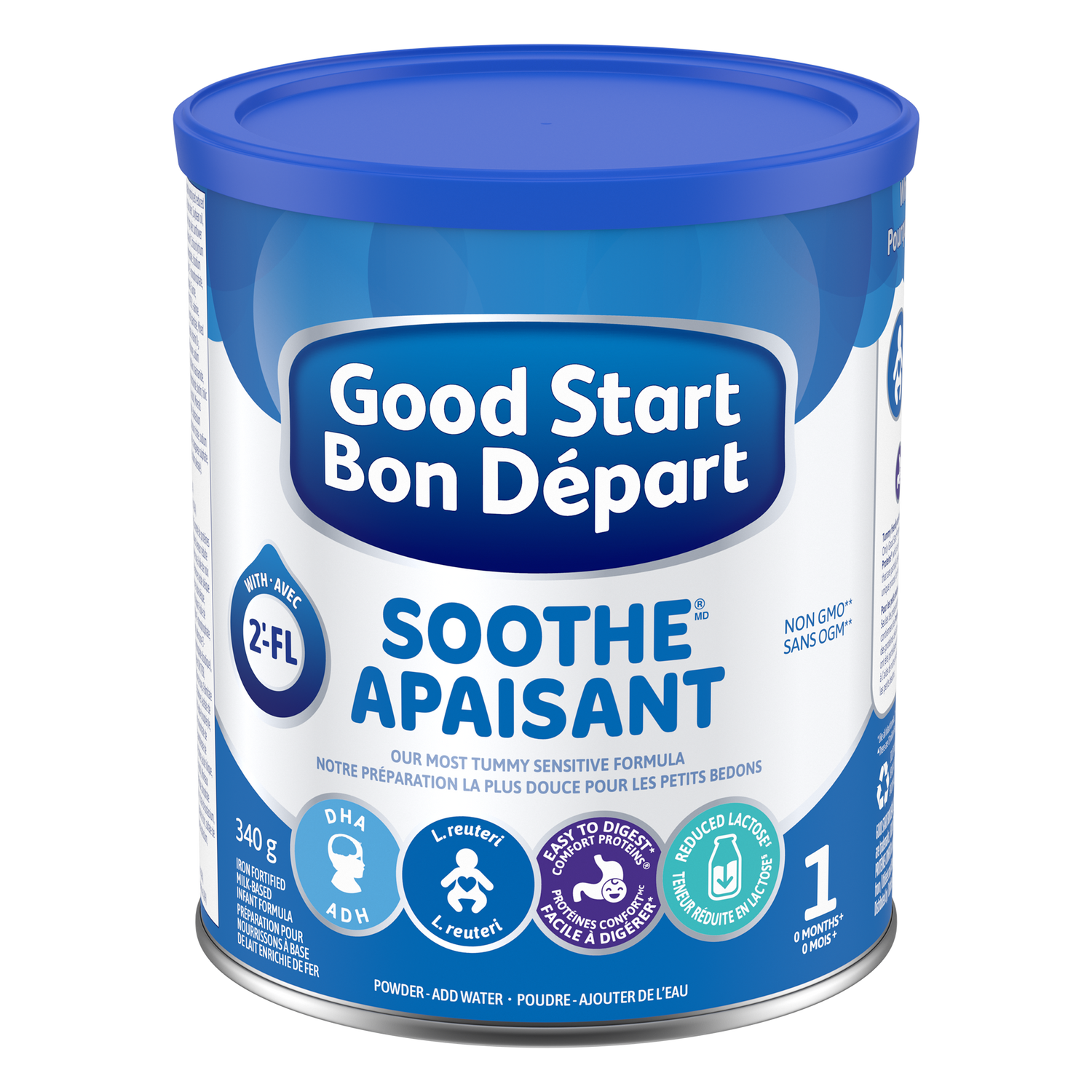Reasons to choose Good Start® Plus Stage 1 Formula
Good Start® is Pediatricians’ #1 choice for easiest formula on baby’s tummy.*
Our closest formula to breast milk, Good Start® Plus 1 powder is the only baby formula with the unique combination of:
Comfort Proteins®
Easy to digestǂ. Only Good Start® formulas have Comfort Proteins®, 100% whey proteins that have been partially broken down with your baby’s tiny tummy in mind – and they have been scientifically shown to help promote softer poop.§1 Learn More.
Probiotics†
Probiotic B. lactis is a good bacteria, like those found in breast milk2, that helps support baby’s healthy gut microbiota.
DHA
Good Start® Plus infant formula has expert recommended levels of DHA3, an Omega 3 fat, which contributes to your baby’s normal physical brain and eye development.
Immune Support
2’-FL is a prebiotic found in breast milkǁ and is shown to help support digestive health and the developing immune system.4-6
Good Start® Stage 1 formulas are available in multiple formats
Sort by:
Stage 1 Baby Formulas
$0.00
Unit price perContaining Comfort Proteins® and essential vitamins and minerals that support baby’s normal growth and development, Good Start® Stage 1 baby formula offers good value in a formula you can trust.
For infants 0 months and up
- Good Start® is Pediatricians' #1 choice for easiest formula on baby's tummy!†
- Tummy friendly and easy to digest*, only Good Start® baby formulas contain Comfort Proteins®, which are 100% whey proteins that are partially broken down for small tummies – and they have been scientifically shown to help promote softer poop§,¹
- Non-GMOǂ
$1.00
Unit price perOur closest formula to breast milk, with the unique combination of Comfort Proteins™, DHA, Probiotic B. lactis, and 2’-FL.
For infants 0 months and up.
- Our closest formula to breast milk
- Good Start® is Pediatricians' #1 choice for easiest formula on baby's tummy!*
- Tummy friendly and easy to digest†, only Good Start® formulas contain Comfort Proteins®, which are 100% whey proteins that are partially broken down for small tummies – and they have been scientifically shown to help promote softer poop§,1
- With probiotic B. lactis, a good bacteria like the ones found in breast milk2, that helps support a healthy gut flora
- Expert recommended levels of DHA3, an Omega 3 fat, which contributes to your baby’s normal physical brain and eye development
- With 2’-FL; 2’-FL is an oligosaccharide found in breast milkǁ that is shown to help support digestive health and the developing immune system4-6
- Non-GMOǂ
$1.00
Unit price perOur closest liquid formula to breast milk with the combination of Comfort Proteins®, DHA, and 2’-FL. Just shake well, open, and pour into a sterilized bottle.
For infants 0 to 12 months
- Our closest liquid formula to breast milk
- Good Start® is pediatricians' #1 choice for easiest formula on baby's tummy!*
- Tummy friendly and easy to digest†, only Good Start® formulas contain Comfort Proteins®, which are 100% whey proteins that are partially broken down for small tummies – and they have been scientifically shown to help promote softer poop§,1
- Expert recommended levels of DHA2, an Omega 3 fat, which contributes to your baby’s normal physical brain and eye development
- With 2’-FL. 2’-FL is an oligosaccharide found in breast milkǁ that is shown to help support digestive health and the developing immune system3-5
- Non-GMOǂ
- No water, no measuring, and no mixing; to prepare, simply shake well, open, and pour into a sterilized bottle
$1.00
Unit price perOur closest liquid formula to breast milk with the combination of Comfort Proteins®, DHA, and 2’-FL. Just shake well, remove the cap, twist on a sterilized standard size nipple and ring, and it’s ready to go!
For infants from 0 months and up
- Our closest formula to breast milk
- Good Start® is pediatricians' #1 choice for easiest formula on baby's tummy!*
- Tummy friendly and easy to digest†, only Good Start® formulas contain Comfort Proteins®, which are 100% whey proteins that are partially broken down for small tummies – and they have been scientifically shown to help promote softer poop§,1
- Expert recommended levels of DHA2, an Omega 3 fat, which contributes to your baby’s normal physical brain and eye development
- With 2’-FL. 2’-FL is an oligosaccharide found in breast milkǁ that is shown to help support digestive health and the developing immune system3-5
- Non-GMOǂ
- No water, no measuring, and no mixing; to prepare, simply shake well, open, and pour into a sterilized bottle
$1.00
Unit price perOur closest liquid formula to breast milk with the combination of Comfort Proteins®, DHA, and 2’-FL. Mixes easily with no clumps or scoops – just add water as directed and shake well.
For infants 0 to 12 months
- Our closest liquid formula to breast milk
- Good Start® is Pediatricians' #1 choice for easiest formula on baby's tummy!*
- Tummy friendly and easy to digest†, only Good Start® formulas contain Comfort Proteins®, which are 100% whey proteins that are partially broken down for small tummies – and they have been scientifically shown to help promote softer poop§,1
- Expert recommended levels of DHA2, an Omega 3 fat, which contributes to your baby’s normal physical brain and eye development
- With 2’-FL. 2’-FL is an oligosaccharide found in breast milkǁ that is shown to help support digestive health and the developing immune system3-5
- Non-GMOǂ
- Comes in an easy-to-use Concentrated Liquid format with a reclosable cap, that mixes easily with no clumps or scoops - just add water as directed and shake well.
$1.00
Unit price perThe first and only formula with probiotic L. reuteri, designed with extra comfort in mind for babies with tummy troubles.
For infants 0 months and up
- Our most tummy sensitive formula, and the only formula with Probiotic L. reuteri
- Over 90% of parents who switched to Good Start Soothe™ baby formula said their baby was less fussy after the first feed*,1
- Tummy friendly and easy to digest†, Good Start Soothe™ baby formula has Comfort Proteins®, which are 100% whey proteins that are partially broken down using our unique process for small tummies – and they have been scientifically shown to help promote softer poop§,2
- Reduced level of lactose**
- Expert recommended levels of DHA2, an Omega 3 fat, which contributes to your baby’s normal physical brain and eye development
- With 2’-FL; 2’-FL is an oligosaccharide found in breast milkǁ that is shown to help support digestive health and the developing immune system3-5
- Non-GMOǂ
Trending Articles
§ Compared to intact protein formulas.
* More Pediatricians trust Good Start® as the most well-tolerated routine infant formula than any other brand. Data on file.
ǂ Like all infant formula
† Powder format only.
ǁ Not derived from human milk.
** Ingredients not genetically engineered.
° ~30% less lactose compared to other Good Start® milk-based infant formulas.
References:
1. Czerkies L. et al. Intl J Pediatr. 2018;2018:4969576
2. Gueimonde M, et al. Neonatology. 2007;92:64-66.
3. ADA/DC. J Am Diet Assoc. 2007;107:1599-1611.
4. Storm H, et al. Glob Pediatr Health. 2019;6:1-10.
5. Bode L, et al. Glycobiology. 2012;22(2):1147-1162.
6. Goehring K, et al. PLoS One. 2016;146(12):2559-2566.



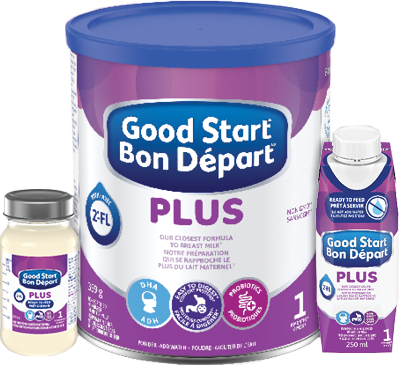
 Good Start® Plus 1 Powder
Good Start® Plus 1 Powder
 Good Start® Plus 1 Ready to Feed Nurser
Good Start® Plus 1 Ready to Feed Nurser
 Good Start® Plus 1 Ready to Feed
Good Start® Plus 1 Ready to Feed
 Good Start® Plus 1 Concentrate
Good Start® Plus 1 Concentrate
 Good Start® 1 Powder
Good Start® 1 Powder
 Good Start SootheTM Powder
Good Start SootheTM Powder
